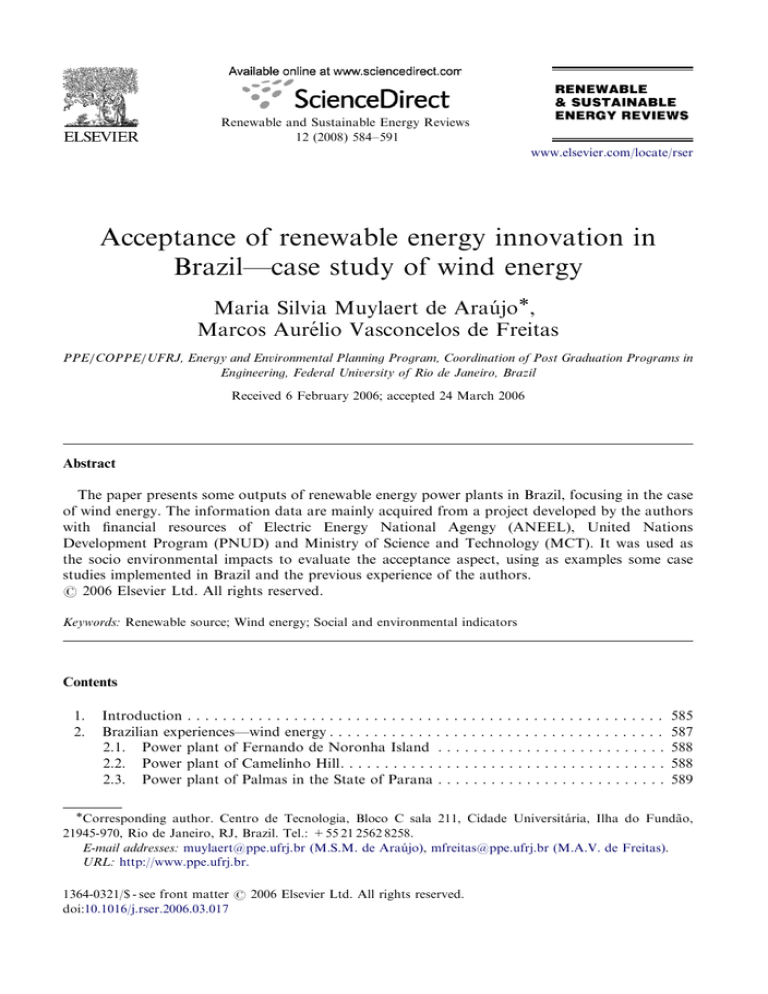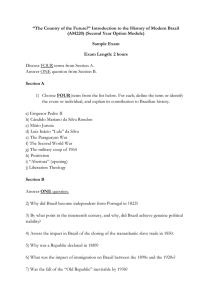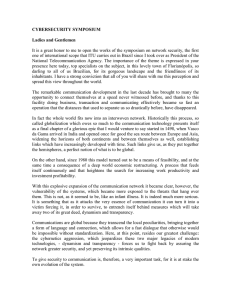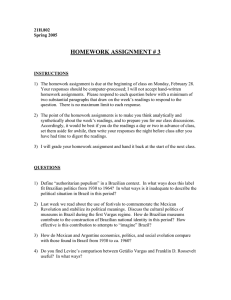
ARTICLE IN PRESS
Renewable and Sustainable Energy Reviews
12 (2008) 584–591
www.elsevier.com/locate/rser
Acceptance of renewable energy innovation in
Brazil—case study of wind energy
Maria Silvia Muylaert de Araújo,
Marcos Aurélio Vasconcelos de Freitas
PPE/COPPE/UFRJ, Energy and Environmental Planning Program, Coordination of Post Graduation Programs in
Engineering, Federal University of Rio de Janeiro, Brazil
Received 6 February 2006; accepted 24 March 2006
Abstract
The paper presents some outputs of renewable energy power plants in Brazil, focusing in the case
of wind energy. The information data are mainly acquired from a project developed by the authors
with financial resources of Electric Energy National Agengy (ANEEL), United Nations
Development Program (PNUD) and Ministry of Science and Technology (MCT). It was used as
the socio environmental impacts to evaluate the acceptance aspect, using as examples some case
studies implemented in Brazil and the previous experience of the authors.
r 2006 Elsevier Ltd. All rights reserved.
Keywords: Renewable source; Wind energy; Social and environmental indicators
Contents
1.
2.
Introduction . . . . . . . . . . . . . . . . . . . . . . . . . . . . . . . . . . . . . . . . . . . . . . . . . . . . . .
Brazilian experiences—wind energy . . . . . . . . . . . . . . . . . . . . . . . . . . . . . . . . . . . . . .
2.1. Power plant of Fernando de Noronha Island . . . . . . . . . . . . . . . . . . . . . . . . . .
2.2. Power plant of Camelinho Hill. . . . . . . . . . . . . . . . . . . . . . . . . . . . . . . . . . . . .
2.3. Power plant of Palmas in the State of Parana . . . . . . . . . . . . . . . . . . . . . . . . . .
585
587
588
588
589
Corresponding author. Centro de Tecnologia, Bloco C sala 211, Cidade Universitária, Ilha do Fundão,
21945-970, Rio de Janeiro, RJ, Brazil. Tel.: +55 21 2562 8258.
E-mail addresses: muylaert@ppe.ufrj.br (M.S.M. de Araújo), mfreitas@ppe.ufrj.br (M.A.V. de Freitas).
URL: http://www.ppe.ufrj.br.
1364-0321/$ - see front matter r 2006 Elsevier Ltd. All rights reserved.
doi:10.1016/j.rser.2006.03.017
ARTICLE IN PRESS
M.S.M. de Araújo, M.A.V. de Freitas / Renewable and Sustainable Energy Reviews 12 (2008) 584–591
3.
2.4. Power plant of Harbor of Mucuripe . . . . . . . . . . . . . . . . . . . . . . . . . . . . . . . . .
2.5. Power plant of Taı́ba . . . . . . . . . . . . . . . . . . . . . . . . . . . . . . . . . . . . . . . . . . .
2.6. Power plant of Prainha . . . . . . . . . . . . . . . . . . . . . . . . . . . . . . . . . . . . . . . . . .
Conclusion . . . . . . . . . . . . . . . . . . . . . . . . . . . . . . . . . . . . . . . . . . . . . . . . . . . . . . .
References . . . . . . . . . . . . . . . . . . . . . . . . . . . . . . . . . . . . . . . . . . . . . . . . . . . . . . .
585
589
589
590
590
591
1. Introduction
It is very important to study the best way to insert alternative sources in the Brazilian
national grid by the growing awareness of the need to reduce the impact of human
activities in such a way as to offer more energy in a sustainable environment. The Brazilian
national grid has a total of 1415 generating enterprises, with an installed capacity of
99,485 GW, causing regional and cross-boarder conflicts for the use of soil, water and
atmospheric pollution both global and local (Table 1).
Wind energy presents several advantages when compared with other energy sources used
in Brazil such as nuclear, hydro and thermo electricity. Its most important attractiveness
relates to the relatively low environmental impacts. Nevertheless, several socio-environmental impacts need to be deeply analyzed to reduce the barriers for the acceptance of the
wind enterprises. The use of wind energy can be domestic but also can be more complex as
in the case of systems linked to the public grids.
Up to the end of 2002, more than 40,000 large Aeolic turbines were in operation in the
world, with an installed capacity on the order of 32,500 MW. More than 50,000 new jobs
were created and a solid industry of components and equipments was developed. The
Aeolic turbine industry is currently growing at over 30% a year with a turnover of 2 billion
dollars a year in sales. The forecast for 2007 is an installed capacity of 58,632 MW. In
Europe, it is expected that 10% of all energy will be wind-generated by 2030.
In Brazil, the use of the wind to generate electrical energy is still on a small scale,
especially considering the great wind potential in Brazil. In 2001, the Ministry of Mines and
Energy (MME) through the Electrical Energy Research Center (CEPEL), published the
Atlas of Brazilian Aeolic Potential, with information about the behavior of the wind all
over the country. This Atlas estimates a potential of 143.47 GW for winds with an average
annual velocity equal to or greater than 7.0 m/s, making available an annual estimated
generation of 272,220 TWh/year, for which an area of 71,735 km2 would be necessary (0.8%
of the national territory). This projection takes as a basis an average occupation density of
2 MW/km2 and performance curves for turbines of a height of 50 m. The Atlas shows some
special privileged areas, including mountain regions, the coast of the northeast, specific
stretches of the south and reasonable average velocities in various parts of the country.
From the point of view of the costs of generation, it is possible to produce electricity
from Aeolic sources at globally competitive prices—from US$ 50 to 70 per MWh,
measured at various locations in Brazil by the Brazilian Center for Aeolic Power. For
beginning results, with the recent changes in regulation standards in the electrical sector,
total Aeolic power in operation in the country rose by more than 14 times in the last seven
years, that is, from around 2 MW in 1997, to 28.6 MW in April 2005, with medium-sized
Aeolic turbines connected directly to the power grid. Also, there are hundreds of windmills
for pumping water and dozens of small wind turbines in isolated places for charging
batteries, telecommunications systems and rural electrification.
ARTICLE IN PRESS
586
M.S.M. de Araújo, M.A.V. de Freitas / Renewable and Sustainable Energy Reviews 12 (2008) 584–591
Table 1
Brazil—power energy grid—2005. Enterprises in operation and their socio-environmental impact
Type of plant
Installed capacity
Number of
plants*
Hydro
Gas
Natural
Process
Petrol-oil
Oil diesel
Oil residual
Biomass
Cane waste
Black liquor
Wood
Biogas
Rice husk
Nuclear
Coal
Aeolic
Socio-environmental impact**
Conflicts in the use of soil and water
Greenhouse gas emissions
(kW)*
569
69,668,107
70.03
70
24
8,975,744
901,800
9.02
0.91
458
19
4,088,875
1,168,278
4.11
1.17
217
12
22
2
2
2
7
2,170,654
665,572
199,632
20,030
6,400
2,007,000
1,415,000
2.18
0.67
0.20
0.02
0.01
2.02
1.42
11
28,625
0.03
5,650,000
2,250,000
200,000
70,000
5.85
2.33
0.08
0.20
99,485,717
100
Imported
Paraguay
Argentina
Venezuela
Uruguai
Total
(%)
1415
Greenhouse gas emissions, acid rain and local
atmospheric pollution
Conflicts in the use of soil, atmospheric and local
water pollution
Risk of accident and nuclear waste
Greenhouse gas emissions, acid rain and
atmospheric and local water pollution
Obstruction to migrating birds, visual impacts,
noise impacts, demand for land
Border conflicts over land usage and ware and
atmospheric pollution (global and local)
Source: [1,2].
*Installed Capacity from National Energy Balance—www.mme.gov.br/ben
**Based on authors report for United Nations Development Program ‘‘Energy Comsumption and Planet
Warming’’ (Consumo de Energia e Aquecimento do Planeta), IVIG/COPPE/UFRJ, 2001.
In the medium term, ANEEL (National Agency for Electricity) has issued permits for
146 businesses working with Aeolic sources with a total of 6679.153 MW, which should
come into operation in the next 5 years (2006–2010). From the economic and technical
point of view, it is possible, without undermining the Brazilian power production system,
to install at least 12,000 MW in the next 10 years. Some initiatives point out the incentive
to wind energy in Brazil. The Inventory of the Aeolic Potential in the Southeastern region
of Brazil (IPERS), is a project conceived together with the Brazilian Aeolic Atlas Project
(AEBr), both carried out in the ambit of the BRA/00/029 Project. The BRA/00/029
project, sponsored by the United Nations Program for Development (PNUD) and
managed by ANEEL, was created to give continuity to the implementation of the activities
previewed in the technical-scientific cooperation agreement between MCT and ANEEL, in
December 1998, and begun in the BRA/95/G31 Project. This project had the participation
of two researchers who integrated an Aeolic subproject that was carried from 1 November
2001 to 8 March 2002. Another important initiative is the wind database—there is an
agreement underway at the moment involving the Department of Mechanical Engineering
ARTICLE IN PRESS
M.S.M. de Araújo, M.A.V. de Freitas / Renewable and Sustainable Energy Reviews 12 (2008) 584–591
587
UNIFEI, (Federal University of Itajubá), through the Foundation of Research of Itajubá
(FUPEPE) and the Laboratory of Alternative Energy Sources (LAFAE) with the MME
for the development and implantation of a database for winds which will carry the data
necessary for a technical and economic feasibility analysis for the enterprises that would
make use of the Aeolic energy.
An important Aeolic energy project in Brazil is the wind farm of the Park of Rio do Fogo.
The Enerbrasil—Energias Renováveis do Brazil, an independent company producing energy
authorized by Aneel, will begin the construction of the Rio do Fogo Aeolic Park in the first
semester of 2006. This wind park was chosen to be built within the Incentives to Alternative
Energy Program (PROINFA). It will be built in the State of Rio Grande do Norte, in the
municipality of Rio do Fogo, which is located about 60 km to the north of Natal, the capital
city of the state, on the coast. The park’s total installed power will be 49.3 MW and the
turbines to be installed will be manufactured in Brazil by Wobben Windpower, a subsidiary
of the German company Enercon. This will be the company’s first Aeolic Park in Brazil.
Another important initiative is the approval by the Brazilian National Bank for Socio
Economic Development for the construction of a Aeolic park of Osório, in the state of Rio
Grande do Sul. The capacity of this park will be 150 MW, which will be considered the
biggest in Brazil and the second in the world and it will employ around 500 direct jobs.
According to the Permanent Forum of Renewable Energy, coordinated by the Science and
Technology Ministry, until the end of 2005, around 1600 Aeolic turbines were foreseen,
each with maximum capacity of 600 kW.
Table 2 presents the main projects of Aeolic energy installed in the country.
According to Table 2, Ceará is an important state in terms of Aeolic energy in Brazil.
The Energy Company of Ceará (COELCE) estimates that the litoral of Ceará presents the
highest potential for Aeolic energy with regular winds during the whole year. A big project
of 60 MW in the litoral of Ceará is foreseen, in the municipalities of Paracuru and
Camocim, 30 MW for each city, 207.000 MWh/ano.
The rise of the participation of Aeolic power in the national power matrix needs to be
planned so that it is inserted into the mix of the Brazilian power system. It is necessary to
carry out regional studies involving social-economic and environmental feasibility taking into
account impacts on the transmission and distribution system, and also an evaluation of social
and environmental repercussions. Until now, there are no formal monitoring activities with
the aim of assessing the effects, for the interested populations, of wind energy projects
surrounding their localities. Nevertheless, some informal communications are available. The
representatives of the Municipal governments of Camocim and Paracuru in Ceará, for
example, declared to the authors of the present paper that the local population was asked
about the future wind projects in their cities. They received general informations with photos
of previous enterprises in other localities. According to them, the people considered the wind
turbines a ‘‘very beautiful sightseeing’’. Besides, it was declared that the majority of the
communities, linked to fish activities, approved the projects because they considered that it
would result in new activities of tourism, more job creation and financial resources. There are
not more details about the conditions and methodologies of the researches.
2. Brazilian experiences—wind energy
The first wind project in Brazil to generate electricity was installed in 1992 in Fernando
de Noronha Island, state of Pernambuco, northeast of the country. It is considered a world
ARTICLE IN PRESS
588
M.S.M. de Araújo, M.A.V. de Freitas / Renewable and Sustainable Energy Reviews 12 (2008) 584–591
Table 2
Main projects of Aeolic energy installed in Brazil, 2005
State
Local
Companies
Installed capacity Energy (MWh/yr)
Ceará
Ceará
Ceará
Minas Gerais
Pará
Paraná
Paraná
Paraná
Pernambuco
Pernambuco
Porto do Mucuripe
Usina da Prainha
Usina Taı́ba
Usina do Morro do Camelinho
Usina de Joanes
Palmas I
Palmas II
Palmas III
Usina de Fernando de Noronha
Centro de Testes de Olinda
TAKE
Wobben—Enercon
Wobben—Enercon
TAKE
Bergey
Wobben—Enercon
Wobben—Enercon
Wobben—Enercon
Folkcenter
Folkcenter
1.2 MW
10.0 MW
5.0 MW
1.0 MW
40 kW
2.5 MW
9.5 MW
50 MW
90 kW
30+225 kW
3800
35,000
17,500
800
Without information
7000
33,600
Without information
Without information
—
Source: Authors.
paradise due to its ecological diversity. From this experience, other projects were
developed in Brazil.
2.1. Power plant of Fernando de Noronha Island
In 1992, the Energy Company of Pernambuco (CELPE), in partnership with the
Company Folkcenter from Denmark and the Group of Wind Energy of Federal University
of Pernambuco, installed the first big wind turbine for commercial operation in South
América. Before that, the Fernando de Noronha Island used thermoelectricity based on
diesel oil with big environmental impacts. The equipment has capacity of 90 kW and a
tower with 23 m high and propellers with diameter of 17 m.
Some problems related to this first Brazilian experience of Aeolic energy ocurred. The
first tentative to put the turbine in operation did not work at all. It was reported by the
Journal of Technology of Pernambuco (edition of April 1993), ‘‘as an unusual component in
the beautiful island landscape, indifferent to the tentatives to force it starting work’’. As
the engineers from Denmark were not in Brazil anymore, the problem had to be solved by
Brazilian engineers but only after 3 months of tentatives. That is why the technology
received the surname of ‘Black Box’.
The Aeolic energy represents around 4% of the total electricity consumed in the
Fernando de Noronha Island nowadays. ANEEL, the Brazilian Center of Aeolic Energy
(CBEE) and the Government of Pernambuco intends to increase the Aeolic energy in the
Island of Fernando de Noronha to 22% as a first step and 50% as a second step.
Some characteristics of the system running in Fernando de Noronha Island: capacity of
90 kW, a tower with 23 m high, propellers with diameter of 17 m, tower with square base,
nominal tension 3–380 Vrms/60 Hz, wind velocity ¼ 12 m/s and start ¼ 3.5 m/s.
2.2. Power plant of Camelinho Hill
The Company of Energy of Minas Gerais (CEMIG) realized measurements and
evaluations of the wind conditions in the Hill of Camelinho during 1983 and 1984.
The results showed that the region had great potential to develop Aeolic energy projects.
ARTICLE IN PRESS
M.S.M. de Araújo, M.A.V. de Freitas / Renewable and Sustainable Energy Reviews 12 (2008) 584–591
589
New studies were realized to implement a large wind system in the local. In 1992, this
project idea was framed in the Eldorado Program of the German Ministry of Science
and Technology, which offered 70% of the total necessary resources for the project
implementation.
The power plant of Camelinho was installed in 1994, with capacity of 1 MW, total cost
of US$ 1,540,000. From this total, US$ 790,000 (51%) were paid by the German
Govenment Eldorado Program and US$ 750,000 (49%), were financed by CEMIG.
According to the project information, the local average velocity was estimated between
6 and 7 m/s, for 30 m high, and a yearly production of around 1500 and 1800 MWh was
foreseen . Some characteristics of the system are four turbines with 250 kW each,
horizontal axis rotor, three propellers with diameter of 26 m, conic tower with 30 m high,
nominal wind velocity of 14 m/s with start velocity of 3 m/s.
2.3. Power plant of Palmas in the State of Parana
Opened in November 1999, the Aeolic Central of Parana, a joint company of Parana
Electric Company (COPEL) (30%) and Wobben Wind Power (70%), a Brazilian
subsidiary of the German Enercom, is already at commercial operation. According to
Wobben, the investment was around US$ 1 million per installed MW.
The capacity of plant is 2.5 MW, with five aerogenerators with 500 kW each. The plant is
installed in the Municipality of Palmas in the south region of the state. The first phase of
the project foresees the availability of energy to the COPEL system during 20 years.
The plant of Palmas works with average wind velocity of 7.5 m/s, around 0.5 m/s
superior to the national average of wind velocity. Nevertheless, the plant only acquires its
nominal capacity with wind up to 12 m/s.
According to COPEL, the plant is able to produce 6.5 million kWh per year, enough to
supply a Municipality with 15,000 inhabitants. It is interlinked to the transmission system
of 34.4 kV with 37 km of lines.
The power plant of Palmas is installed in a local with altitude of 1300 m related to the sea
level. The aerogenerators are 44 m high, sustained by steel tubular towers. Each
aerogenerator has three fiberglass propellers. The energy production requires a minimum
wind velocity of 3 m/s and this must be present approximately 95% of the time.
2.4. Power plant of Harbor of Mucuripe
From the data obtained by the Aeolic Map Project of the State of Ceara [3], the
COELCE projected and constructed an Aeolic park with 1.2 MW in Fortaleza, in Praia
Mansa—Harbor of Mucuripe.
The park was a result of cooperation of several enterprises; four Aeolic turbines were
utilized, manufactured by the Tacke Windtechnique, with nominal potential of 300 kW
each and 33 m of the rotor diameter. The project was framed by the German Government
Eldorado Program, which supported 50% of the cost of the enterprise.
2.5. Power plant of Taı´ba
According to Wobben, the investment was around US$ 1 million per installed MW. The
power plant has 5 MW of capacity, 10 aerogenerators with 500 kW each. It is located in the
ARTICLE IN PRESS
590
M.S.M. de Araújo, M.A.V. de Freitas / Renewable and Sustainable Energy Reviews 12 (2008) 584–591
Municipality of São Gonc- alo do Amarante, in Taı́ba Beach, litoral of Ceara. It was
constructed on movable sand dunes and occupies an area of 100 ha.
The aerogenerators are installed at 44 m high, sustained by tubular steel towers. The
aerogenerators have three fiberglass propellers with 20 m length. Energy production starts
from minimum wind velocity of 3 m/s. The rotors follow automatically the direction of air
currents maximizing the process. The power plant is controlled, monitored and operated at
a distance by computer.
2.6. Power plant of Prainha
With towers and propellers pre-manufactured in Brazil, the Power Plant of Prainha was
the first Aeolic plant in the world installed on movable sand dunes. It is in Prainha at the
Municipality of Aquiraz, litoral of Ceará state, northeast of Brazil. It occupies 100 ha and
the investment was approximately US$ 1 million per MW installed. The capacity of the
plant is 10 MW, with 20 aerogenerators of 500 kW each.
3. Conclusion
The operation of wind energy for electricity generation does not pollute the atmosphere
and result in a fossil fuel use reduction [4]. However, it demands huge amount of financial
resources, technical adaptation requirements and social acceptance for developing
countries. The modern tubular tower turbines (the older ones were structured with
interlaced metal) apply aeronautic engineering principles to generate energy. The design of
the propellers like airplanes wings and the local choice of the site-specific installation have
huge influence for the acceptance of the visual impact of an Aeolic enterprise. Besides,
Table 3
Important aspects for Aeolic energy projects
Wind energy
Generation capacity, etc.
Existent technologies
Materials
Structuring the pieces in the ground
Depending on the complexity degree of the system (since small
aerogenerators with 16 m diameter for the rotor to the big aerogenerators
with diameter up to 48 m), the onshore or offshore application and the
accessibility for the maintenance, the acceptance of the wind project is
affected.
There are equipments with vertical (darrieus) or horizontal (propellers) axis.
Darrieurs result in great wear for the equipments and huge land area is
necessary to install because of horizontal shovels for the vertical axis. There
are rotors with 1,2,3 or 4 propellers that present different static and dynamic
equilibriums which interferes in the so-called vibration problems. Rotors
with 3 propellers are considered the best at this aspect.
At present the equipments are made of fiberglass covered by resin, which
minimize the noise pollution, and the towers are made of steel, which result
in a light appearance.
The sightseeing and security feeling about the enterprise vary a lot
depending on the local of the site specific. In Brazil, there are wind plants on
sand dunes; hills; and pasturelands. The surroundings are affected after a
wind plant implementation, as it is necessary to guarantee the wind quality
for it. Sometimes, the best place for a wind plant construction is (or may
affect) at a private land and the acceptance depends on the landowner.
ARTICLE IN PRESS
M.S.M. de Araújo, M.A.V. de Freitas / Renewable and Sustainable Energy Reviews 12 (2008) 584–591
591
Table 3 (continued )
Wind energy
Operational and social issues
How to carry out the pieces of a wind
power plant
Job creation; teams for operation and
maintenance
Lack of wind energy
Environmental issues
Noise impacts
Visual impacts
Birds route impacts
Financial and economic issues
Wind energy costs
In general, the pieces arrive by ships. In Brazil, there are wind plants very far
from the litoral, such as the Power Plant of Camelinho Hill, making difficult
machinery transportation through some ecological protected areas. In the
case of Fernando de Noronha Island, the turbine is installed in the Hill what
created a problem of socio-environmental impact during the transportation
of the equipments. The assembly of the equipments demands attention
because of the huge weight of the pieces In Brazil, for the three aeolic plants
Prainha, Taı́ba and Palmas, it was necessary to use a 400 t crane (only one
was in the South of the country), and each aerogenerator took 2 days to be
set up. Some risks of accident have to be studied.
In general, small teams are necessary. O&M does not demand many jobs. It
is possible to operate, and control at a distance by computers.
There are doubts about the efficiency of wind plants due to the possibility of
lack of wind forcing to link the wind energy to a hybrid system with hydro
and thermoelectricity. Other doubt relates to the difficult to store the wind
energy for later use.
Vary according to equipments’ specifications. Turbines multivane fans are
usually noisier.
That is one of the most critical problems to be considered in a wind power
plant in Brazil. There is no awareness of the interference of a wind plant in a
landscape sightseeing. The information about this type of energy source
emphasizes mainly the bucolic aspect of the Aeolic energy. Plants of Taı́ba
and Prainha in Ceara state are 1500 m from the seashores, and the tourists
can use the beaches. In these particular cases, the aerogenerators are
considered ‘‘postal cards’’ of the region, attracting lots of visitors to the
local.
It is a very important issue in Brazil cases due to the migration of several
birds in the country.
This kind of source needs subsidy in Brazil. The kWh is too much expensive
than the hydro, biomass, and thermoenergy sources. The majority of the
equipments has to be imported which is difficult for private investors
initiatives. Exchange time for the investments is around 10 years, depending
on the stability of the economy policy.
There is some expectation of acquirement of carbon credits certifies from
wind projects by the replacement of fossil fuel energy power plants.
other fundamental issues are considered for the evaluation of the acceptance of wind
power projects mentioned in Table 3.
References
[1] ANEEL—Agência Nacional de Energia Elétrica, /www.aneel.gov.brS 2005.
[2] Muylaert de Araujo MS, Rosa LP. Carbon emission mitigation measures in Brazil—case study of biomass
policy for a ferroalloy plant in Ceará State. Renew Sust Energy Rev 2006;10(6):590–602.
[3] ANEEL—Agência Nacional de Energia Elétrica, 2002: Atlas de Energia Elétrica do Brasil, Brası́lia, Brasil.
[4] Silva NF, Rosa LP, Araújo MR. The utilization of wind energy in the Brazilian electric sector’s expansion.
Renew Sust Energy Rev 2005;9:289–309.





